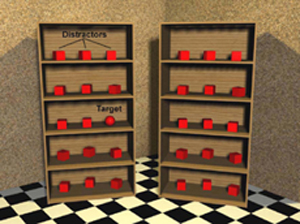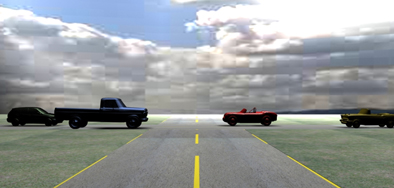Part III - Compensation of the visual Field Loss in Hemianopic Patients
In this part of the PhD-project patients with homonymous
hemianopia (H.H.), a kind of visual field loss (scotoma) were
investigated in order to analyze their ability to compensate
functionally for the visual limitations.
In Germany each year more than 135,000 patients falling ill of one kind
of hemianopia. As main reasons strokes, brain tumors, and inflammations
are known. Because H.H. is common and patients can become diseased with
it in young years, this impairment takes place a special position
within all other visual field losses. The patiens with H.H. are
insufficient or not at all able to read, write, or to avoid obstacles
or persons. With this, patients have a lot of problems to cope tasks of
the everday life.
In different studies hemianopic patients have been investigated to get
more information about their oculomotoric strategies due to
compensation. It could be shown that patients with H.H. need more time
to solve a dot counting task, have an increased scanpath length, and
show a higher number of fixations compared with normal subjects as a
control group. Also the repetition rate of the scanpath as well as the
number of refixations were increased.
In order to assess the compensational strategies of H.H. patients in a
variety of tasks with different demands concerning perception,
processing, and memorization (i.e., cognitive demands), a experimental
'toolbox' including three tasks was introduced. Here, the cognitively
least demanding task was dot-counting. More challenging and including
feature extraction and a certain amount of memorization, comparative
visual search was included as second task. In the third experiment, the
intersection task, subjects were confronted with a dynamic,
multi-object environment and had to interact with it. The task of
collision avoidance in the intersection experiment was the most
challenging one, concerning cognitive processing.
In all tasks eye and head movements were measured in order to
investigate and evaluate the compensational mechanisms used by the
patients.
follow the link to the Comparative Visual Search
 follow the link to the Intersection Task
follow the link to the Intersection Task
